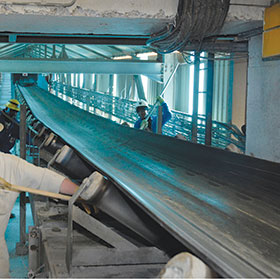

The transport of materials is a key activity for most industries. For many of these tasks, conveyor belt systems offer a cost effective and efficient solution. However, with such a system comes a high risk of fire due to heat generated by belt friction and fire risks associated with the material conveyed.
Belt slipping can occur when rollers seize or when a belt gets worn and slack. Slipping causes friction that can quickly generate enough heat to cause the belt to catch fire. There are some materials, coal for example, which have the ability to self-ignite and start smouldering from the associated heat build-up. If the conveyor is not shut down immediately, or the hot spot cooled down before a fire starts, the entire system may be destroyed, or the fire conveyed from one area to the next, spreading throughout the plant. Once a fire has started on a conveyor belt, it is often very difficult to extinguish. This may be due to the flammability of the product conveyed or the properties of the belt itself.
IR protection systems
Over the past decade, there has been a shift towards a combined approach of fire detection and fire prevention: a heat detection system as early warning and a fire prevention system as a failsafe.
The conventional ways of measuring temperature with contact probes like thermocouples and RTDs/PT100s is not suitable to this type of application. The problems of drag, friction and static generation rule out contact measurement. Also, response time is critical on today’s fast moving conveyors as slow response allows hot spots to pass by the detector before an alarm condition can be registered.
The solution is non-contact infrared thermometers, also known as pyrometers, which have a very fast response (measured in milliseconds), and they do not make contact with the surface under measurement. This makes them ideal for conveyor belt monitoring. A pyrometer is installed for each roller bearing with an alarm triggered if the bearing temperature rises above a pre-determined threshold. Actual position and layout of belt sensors will be determined by the design of the conveyor and the type of material conveyed. In essence this would be an overlapping scan across the belt, where, if a hot spot is detected, it can trigger automatic spray of cooling agent or even stop the conveyor.
With many different models of infrared units available in the Raytek and Fluke Process Instruments ranges, it is easy to select the correct unit for an application. The product being transported will determine the temperature range considered safe, the distance from the sensor to the product will determine the optical resolution, and the conveyor speed will fix the response of the instrument required. Environmental conditions like smoke, dust and adverse weather conditions will determine what other accessories are required like IP rating, or air purge collars for the lenses.
On large coal and coke moving conveyors, the Raytek TX and MI3 systems have been used throughout South Africa and the world. These large conveyor systems have the detectors integrated into their trip systems and any spike of temperature from a hot spot in the product causes an alarm trigger. To design a system suitable for specific plant conditions, R&C Instrumentation is available to consult on its fixed automation systems or portable infrared temperature measuring products.
For more information contact R&C Instrumentation, +27 11 608 1551, [email protected], www.randci.co.za
| Tel: | +27 11 608 1551 |
| Email: | [email protected] |
| www: | www.randci.co.za |
| Articles: | More information and articles about R&C Instrumentation |

© Technews Publishing (Pty) Ltd | All Rights Reserved